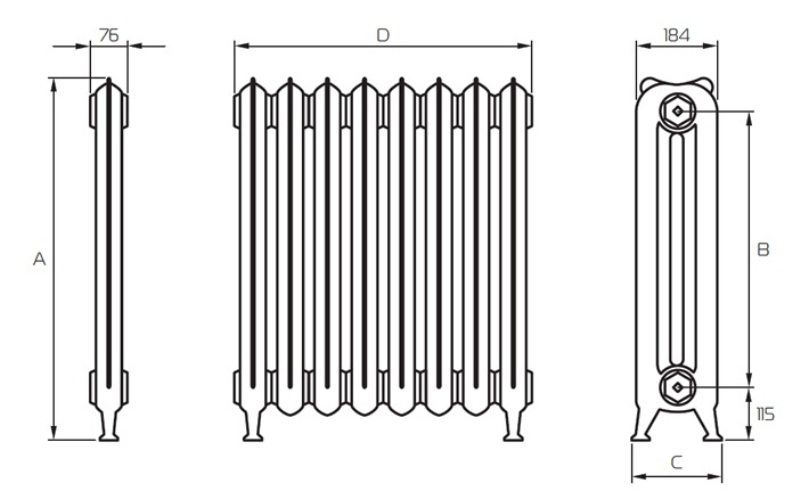It is not difficult to calculate the optimum cross-section of a pipeline to a professional. Practical experience + special tables - all this is enough to make the right decision. But how to be an ordinary owner of a home? After all, many prefer to install the heating circuit on their own, but they do not have a specialized engineering education. This article will be a good clue for those who need to determine the diameter of the pipe for heating a private house.
There are several nuances that you need to pay attention to:
- First, all the data obtained from calculations by formulas are approximate. Different rounding of values, averaged coefficients - all this introduces a number of corrections to the final result.
- Secondly, the specific operation of any heating circuit has its own peculiarities, therefore any calculations give only approximate data, "for all cases."
- Third, the tubular products are produced in a certain assortment. The same applies to diameters. The corresponding values are located in a certain row, with a gradation by values. Therefore, it is necessary to select the nominal value closest to the calculated one.
Based on the foregoing, it is advisable to use the practical recommendations of professionals.

All Do's are in "mm".In parentheses - for systems with natural coolant circulation.
- The total pipe of the line is 20( 25).
- Taps to batteries - 15( 20).
- With single-pipe heating circuit, diameter 25( 32).
But these are common parameters of the circuit, not taking into account its specificity. More accurate values are shown in the table.

What is considered when choosing the pipe diameter
Power of the heat generator. It is taken as a basis and is determined individually for each structure. What does the owner look for when buying a boiler? On the cumulative area of all heated premises. This is exactly what the manager at the point of sale will specify, if the buyer has questions about this item.
 Coolant velocity. If it is less than 0.25 m / sec, then there is a risk of air-conditioning of the system, the formation of traffic jams on the track. Exceeding the value of 1.5 is fraught with "noise" in the highway. This is particularly noticeable when the pipes are made of metal, and even laid open way. But in any case, moving the coolant along the track will be well auditioned.
Coolant velocity. If it is less than 0.25 m / sec, then there is a risk of air-conditioning of the system, the formation of traffic jams on the track. Exceeding the value of 1.5 is fraught with "noise" in the highway. This is particularly noticeable when the pipes are made of metal, and even laid open way. But in any case, moving the coolant along the track will be well auditioned.
It has been proved by practice that for a private structure( with an autonomous heating circuit) it is necessary to focus on the indicator in the range from 0.3 to 0.7.This is the optimal value for any system.
Contour configuration. In private houses during its installation, as a rule( regardless of the scheme), all the "threads" are put on the collector. Each of them is "loaded" on a certain number of radiators. It makes no sense to purchase pipes of the same diameter for all the lines, if we take into account that the larger the section of the billet, the higher the price of 1 m.
Pipe diameter. Outside special role does not play, because the products from different materials have differences in the thickness of the wall. This parameter indicates only the convenience of attaching the product. Internal diameter - about the throughput of the route. It is he who is decisive.
Pipe diameters are usually denoted in inches. For us, this is an unusual( non-metric) system, so you should know the rules for translating quantities. The ratio of an inch to a centimeter is ½, 54( or 25.4 mm).The pipe material is metal plastic, steel, PP, PE.
Specificity of the structure. First of all, this refers to the effectiveness of its thermal insulation - from what materials it is mounted, by what method and so on.
Practical recommendations for
- Incorrect choice of product diameters is fraught with many troubles: leaks( due to hydrodynamic impacts or overpressure in the pipeline), increased consumption of electricity / energy( fuel) due to low efficiency of the system and a number of others. Therefore, mount it according to the principle of "like a neighbor( kuma, brother-in-law)" does not follow.
- If the circuit consists of dissimilar pipes, then you will have to make special calculations for each section( line) of the route. Separately - for plastic, metal( steel, copper), apply different coefficients and so on. Only a specialist can solve this problem. In such situations it is not necessary to deal with calculations independently, since the error can be very significant. Professional services will cost much less than the subsequent rework of communications, and even in the heating season.
- Connection of all devices( expansion tank, batteries and others) of the circuit is carried out by pipes of the same cross-section.

To avoid the formation of airlock( in the case of some errors in the calculations) on each line should be installed so-called air vent.


